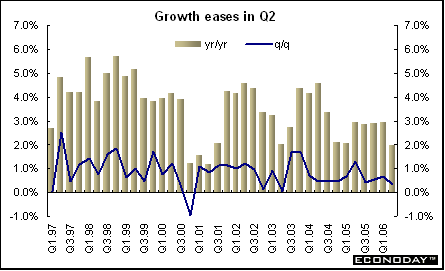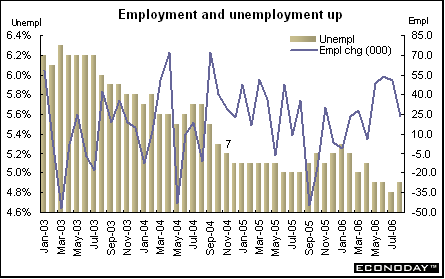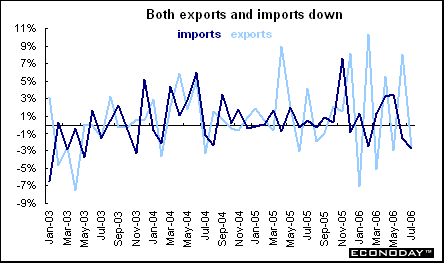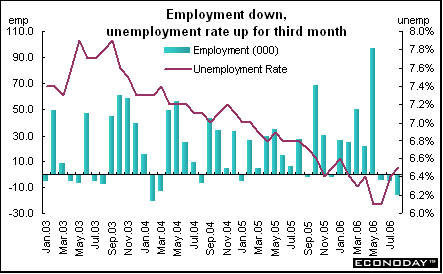Four major central banks have met in recent days and none have changed their policy interest rate. The ECB started the meeting parade on the last day of August and was the most hawkish of the lot. Using their code word "Vigilance," President Jean Claude Trichet led bank watchers to the conclusion that a rate increase is imminent, most probably when the Bank meets on the first Thursday of November. The first to meet so far in September was the Reserve Bank of Australia followed by the Banks of Canada, England and Japan.
Reserve Bank of Australia
Ian MacFarlane chaired his last meeting as governor of the Reserve Bank of Australia on September 5th and left the Bank's policy interest rate at 6 percent. The RBA had increased its rate to that level at its August meeting. MacFarlane, governor for 10 years, will be replaced on September 18th by the deputy governor, Glenn Stevens. Like the U.S., Canada and Japan, second quarter growth disappointed as the economy gave evidence of a weakened consumer hit by higher interest rates, high gasoline prices and a stalled housing market. Consumer spending accounts for about 60 percent of Australia's GDP. The Fed has been steadily closing the interest rate gap - the spread is currently 75 basis points.

Bank of Canada
As expected, the Bank of Canada left its policy interest rate at 4.25 percent where it has been since May. In its accompanying statement, the Bank noted that growth was below their expectations while inflation was higher. They pointed to the moderating trend in the U.S. economy as dampening Canadian growth. At the same time it said that growth elsewhere had improved. It blamed its weakening growth on a drop in exports. But the Bank still thought that the underlying trends appeared to be in line with its projections. Canadian interest rates have been below those in the U.S. since March 2005. During that time, the value of the Canadian dollar is up about 9 percent verses the U.S. dollar. The Bank of Canada typically releases a statement outlining the basis of its decision.

Bank of England
After its surprise increase in interest rates at its July meeting, the Bank of England left its policy interest rate at 4.75 percent for the second month. This is 50 basis points below the U.S. Fed funds rate. Since its August meeting, the economy has performed pretty much as the Bank expected as outlined in its August Inflation Report. The report noted that growth was above its long term trend and the Bank expected manufacturers, retailers and other service companies to enjoy above par performance. Most analysts anticipate that the Bank will increase interest rates again before the end of 2006. As usual, the Bank did not release any statement; Bank watchers will have to wait until September 20th to learn about the deliberations.

Bank of Japan
Bank of Japan Monetary Policy Board unanimously held their key interest rate unchanged at 0.25 percent for a second month after increasing it from near zero in July. The July increase had been the first in six years. Bank of Japan Governor Toshihiko Fukui said at his press conference after the meeting that consumer prices will continue to increase. This reinforced speculation the Bank will increase interest rates before the end of 2006. He said the Bank continues to think that interest rates should be adjusted gradually depending on the economy and prices.

Global Markets
All major equity indexes were down in the first week of September with the exception of the Singapore STI. And with a plethora of central bank meetings, investors had ample policy fodder for input as they reevaluated and reconfigured their portfolios in post-vacation light. In addition to the outcomes of the RBA and the Banks of Canada, England and Japan, global investors examined the Federal Reserve's Beige Book for policy hints for the upcoming FOMC meeting on September 20th. Investor optimism about U.S. interest rates waxes and wanes as each new set of data is released. Last week, for example, sentiment was weighed down by news of a much sharper-than-expected increase in labor costs during the first six months of 2006. Oil prices struck a positive note. They stayed under the $70 a barrel level all week and were under $67 on Friday.
Global Stock Market Recap

Europe and the UK
The CAC, DAX and FTSE were down last week despite the bookend increases on Monday and Friday. European stocks hit one-month lows Thursday as investors worried about global inflation in light of the U.S. unit labor cost report and its impact on the future path of U.S. interest rates. Prospects of a declining housing market again in the U.S. depressed investors. It would hurt commodity prices and their producers (many are listed on the FTSE) along with exporters. Copper led declines on the London Metal Exchange on speculation that demand will drop because of the slowdown in the U.S., which is the world's second-largest user of the metal. But on Friday, earnings prospects once again boosted optimism and stocks were up. In Europe, forecasts for faster growth also contributed to a more buoyant frame of mind - at least for the day.

Asia/Pacific
All but the STI ended the week lower. Interest rate concerns continued to weigh on equity investors as they awaited the outcome of the Bank of Japan meeting and listened to hawkish comments from U.S. Federal Reserve officials. Investors continue to fret on uncertainties surrounding U.S. growth. Exporters are concerned the weakening housing market will radiate through the region. Exporter profits may not only suffer but so could the power to increase prices. On Friday, most indexes were up to end the week on a positive note. However, the increases were not enough to offset earlier declines.

August Japanese bank lending was up for a seventh month as companies sought cash to fund increases in spending, according to a Bank of Japan report. The report was viewed favorably by investors still reeling from the tepid second quarter growth in Japan and the United States.
Currencies
The euro was down against the dollar last week, but the yen, despite intra-week fluctuations, was virtually unchanged. The dollar reached a six-week high against the euro on speculation U.S. inflation will force the Fed once again to increase interest rates this year.

But the yen rallied to a four-week high against the euro during the week amid signs that the weak yen is starting to worry European politicians. Thomas Mirow, Germany's deputy finance minister, said the yen would be on the agenda at the upcoming meetings of the International Monetary Fund and at the Group of Seven meetings next week in Singapore. It should be noted that the official agenda released today by the Japanese Ministry of Finance (Japan is the host nation) for the G7 meeting does not include any currency items. And BoJ governor Toshihiko Fukui said at his press conference that he did not expect the yen to be at the center of the talks.

Indicator scoreboard
EMU - July producer price index was up 0.6 percent and 5.9 percent when compared with last year. Energy prices, which were blamed for the uptick in the PPI, were up 1.8 percent and 15 percent on the year. Excluding energy, the PPI was up 0.3 percent and 3.8 percent on the year.

July retail sales were up 0.6 percent and 2.5 percent when compared with the same month a year ago. Food, drinks & tobacco sales jumped by 0.9 percent while non-food sales were up 0.3 percent. A decline in German sales was offset by increased sales in France.

Germany - July manufacturing orders jumped by 1.8 percent and were up 7.4 percent when compared with last year. Domestic orders were up 1 percent while foreign orders jumped by 2.5 percent. Domestic demand for investment goods soared by 4.5 percent while consumption goods were up 1 percent. Foreign demand for investment goods were up 4.4 percent.

July industrial production was up 1.1 percent and 4.6 percent when compared with last year. Manufacturing production was up 1.2 percent and 5.1 percent on the year. Capital goods were up 1.8 percent and 5.6 percent on the year while consumer goods were up 0.4 percent and 0.8 percent on the year. Within consumer goods, durables output was up 3.2 percent and 6.7 percent while nondurables were down 0.1 percent and down 0.3 percent on the year.

July seasonally adjusted merchandise trade surplus was virtually unchanged at €11.9 billion. Exports were up 2.3 percent while imports were up 2.8 percent.

Italy - Second quarter gross domestic product was up 0.5 percent and 1.5 percent when compared with the same quarter a year ago. Capital investment was up 1.2 percent and 2.9 percent on the year. Investment in transportation equipment was the main driver. Domestic consumption was up a weak 0.2 percent and 1.3 percent on the year.

Britain - July industrial output was up 0.2 percent but down 0.5 percent when compared with last year. Manufacturing output was up 0.2 percent and 1.1 percent on the year. Growing strength in manufacturing was offset by a weak energy sector that depressed the overall industrial sector. Electricity, gas & water output dropped 1.8 percent while oil and gas output sank 4.8 percent.

Asia
Australia - Second quarter gross domestic product was up 0.3 percent and 1.9 percent when compared with the same quarter a year ago. This was the slowest pace in three years as higher interest rates and record fuel prices curbed consumer spending. Consumer spending was up 0.6 percent and 2.6 percent on the year. Private business investment was up 2 percent on the quarter and 11.5 percent on the year. Although dwellings were up 3.7 percent, they were 4 percent below last year's level.

August employment was up for the 10th straight month and climbed by 23,400 jobs. The unemployment rate edged up to 4.9 percent from a 30-year low of 4.8 percent primarily because more people entered the labor force. Full-time jobs were up 22,600 and part-time employment climbed by 700. The participation rate, which measures the labor force as a percentage of the population aged over 15, rose 0.2 percentage points to a record 65.1 percent.

July merchandise trade deficit declined to A$588 million from A$635 million in the previous month. Exports were down 2.6 percent while imports tumbled 2.8 percent. Non-rural and other goods exports sank 5 percent but rural exports were up 2 percent as were services credits. Intermediate and other goods imports dropped 4 percent while capital goods sank 8 percent. However both consumption goods and services were up slightly.

Americas
Canada - August employment was down by 16,000 jobs while unemployment edged upward to 6.5 percent from 6.4 percent in July. Full time employment was up by 46,600 jobs but this gain was more than offset by a decline of 62,600 part time jobs. Manufacturing jobs were down by 11,300 while 20,000 jobs were lost in education services. Services jobs were up 2,000 while profession, scientific & technical services gained 19,000 jobs.

Bottom line
Four central banks met last week but none changed their interest rate policies. However, only the Bank of Japan indicated that interest rates could go up soon. In the previous week, the ECB left little doubt that rates would be increased as soon as their October meeting. Indicator releases offered few surprises. In Germany, manufacturing orders and industrial production registered healthy gains and counterbalanced concerns that growth could be faltering. Similarly, most forecasts for the EMU were increased for the year going forward.
On Saturday, September 16th the Group of Seven finance ministers will meet in Singapore in conjunction with the IMF annual meeting. Japan's Ministry of Finance is the host. Although speculation has been rife in the currency markets that the weak yen could be discussed, foreign exchange does not appear to be an item on the 'official' agenda.

